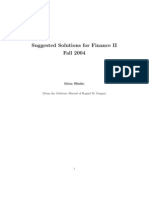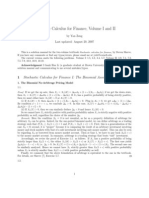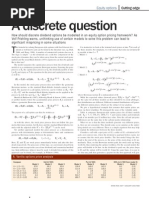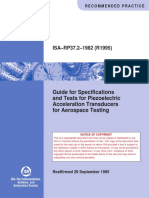Stochastic Calculus For Finance II - Some Solutions To Chapter VI
Uploaded by
Aditya MittalStochastic Calculus For Finance II - Some Solutions To Chapter VI
Uploaded by
Aditya MittalStochastic Calculus for Finance II
-
some Solutions to Chapter VI
Matthias Thul
January 3, 2012
Exercise 6.1
(i) Let
A(u) =
_
u
t
(v)dW(v) +
_
u
t
_
b(v)
1
2
2
(v)
_
dv
such that Z(u) = exp {A(u)}. For u = t, both integrals evaluate to zero and thus
A(t) = 0 and Z(t) = 1. Let f(u, x) = e
x
with
f
u
= 0,
f
x
= e
x
,
2
f
x
2
= e
x
.
Applying Itos lemma yields for u t
dZ(u) = df(u, A(t))
= Z(u)dA(u) +
1
2
Z(u)dA(u)dA(u)
=
_
b(u)
1
2
2
(u)
_
Z(u)du + (u)Z(u)dW(u) +
1
2
2
(u)Z(u)du
= b(u)Z(u)du + (u)Z(u)dW(u) (q.e.d.).
(ii) By the Ito product rule, we have
The author can be contacted via <<firstname>>.<<lastname>>@googlemail.com and
http://www.matthiasthul.com.
1
dX(u) = d (Y (u)Z(u))
= Y (u)dZ(u) + Z(u)dY (u) + dY (u)dZ(u)
= b(u)X(u)du + (u)X(u)dW(u) + (a(u) (u)(u)) du + (u)dW(u) + (u)(u)du
= (a(u) + b(u)X(u)) du + ((u) + (u)X(u)) dW(u) (q.e.d.).
Finally, using the previous result for Y (t) and Z(t) we see that X(t) = Y (t)Z(t) = x.
Exercise 6.2 (No-Arbitrage Derivation of Bond-Pricing Equation)
(i) The self-nancing portfolio process X(t) is given by
dX(t) =
1
(t)df (t, R(t), T
1
) +
2
(t)df (t, R(t), T
2
)
+R(t) (X(t)
1
(t)f (t, R(t), T
1
)
2
(t)f (t, R(t), T
2
)) dt.
Thus, by the It o product rule,
d(D(t)X(t)) = D(t)dX(t) + X(t)dD(t) + dD(t)dX(t)
=
1
(t)D(t)df (t, R(t), T
1
) +
2
(t)D(t)df (t, R(t), T
2
)
+R(t)D(t) (X(t)
1
(t)f (t, R(t), T
1
)
2
(t)f (t, R(t), T
2
)) dt
R(t)D(t)X(t)dt
=
1
(t)D(t) [R(t)f (t, R(t), T
1
) dt + df (t, R(t), T
1
)]
+
2
(t)D(t) [R(t)f (t, R(t), T
2
) dt + df (t, R(t), T
2
)] .
Here, we used that
dD(t) = R(t)D(t)dt
has zero quadratic variation such that the cross-variation term in the It o dierential
drops out. Assuming that the zero-coupon bond price is smooth enough such that
the Ito formula can be applied, then its dierential is given by
2
df(t, R(t), T) = f
t
(t, R(t), T)dt + f
r
(t, R(t), T)dR(t) +
1
2
f
rr
(t, R(t), T)dR(t)dR(t)
= f
t
(t, R(t), T)dt + (t, R(t))f
r
(t, R(t), T)dt + (t, R(t))f
r
(t, R(t), T)dW(t)
+
1
2
2
(t, R(t))f
rr
(t, R(t), T)dt.
Combining this with the previously obtained dynamics of the discounted portfolio
value yields
d(D(t)X(t)) =
1
(t)D(t) [R(t)f (t, R(t), T
1
) + f
t
(t, R(t), T
1
) + (t, R(t))f
r
(t, R(t), T
1
)
+
1
2
2
(t, R(t))f
rr
(t, R(t), T
1
)
_
dt +
2
D(t) [R(t)f (t, R(t), T
2
)
+f
t
(t, R(t), T
2
) + (t, R(t))f
r
(t, R(t), T
2
) +
1
2
2
(t, R(t))f
rr
(t, R(t), T
2
)
_
dt
+D(t)(t, R(t)) [
1
(t)f
r
(t, R(t), T
1
) +
2
(t)f
r
(t, R(t), T
2
)] dW(t).
This is the rst equality in Equation (6.9.4). To get the second equality, we simply
substitute (t, R(t), T) and obtain
d(D(t)X(t)) =
1
(t)D(t) [(t, R(t)) (t, R(t), T
1
)] f
r
(t, R(t), T
1
) dt
+
2
(t)D(t) [(t, R(t) (t, R(t), T
2
)] f
r
(t, R(t), T
2
) dt
+D(t)(t, R(t)) [
1
(t)f
r
(t, R(t), T
1
) +
2
(t)f
r
(t, R(t), T
2
)] dW(t) (q.e.d.).
(ii) We rst note that by construction of the trading strategy
1
(t)f
r
(t, R(t), T
1
) +
2
(t)f
2
(t, R(t), T
2
)
= S(t)f
r
(t, R(t), T
1
) f
r
(r, R(t), T
2
) S(t)f
r
(t, R(t), T
1
) f
r
(r, R(t), T
2
)
= 0.
Thus, the diusion term in the dynamics of D(t)X(t) vanishes and the portfolio is
instantaneously risk-free. Furthermore,
3
1
(t)D(t) [(t, R(t)) (t, R(t), T
1
)] f
r
(t, R(t), T
1
)
+
2
(t)D(t) [(t, R(t) (t, R(t), T
2
)] f
r
(t, R(t), T
2
)
= S(t)D(t) [ (t, R(t), T
2
) (t, R(t), T
1
)] f
r
(t, R(t), T
1
) f
r
(t, R(t), T
2
)
0.
The last inequality follows from the denition of S(t). For no-arbitrage to exist,
the discounted wealth process of a risk-free portfolio has to be a martingale and
thus, the drift has to vanish. This is only the case if (t, R(t), T
2
) = (t, R(t), T
1
).
Since T
1
and T
2
are arbitrary maturities, we conclude that (t, R(t), T) has to be
independent of T.
(iii) The discounted portfolio process immediately follows from the result obtained in (i)
by setting T
1
= T,
1
(t) = (t) and
2
(t) = 0 for all t 0. Then
d(D(t)X(t)) = (t)D(t) [R(t)f(t, R(t), T) + f
t
(t, R(t), T) + (t, R(t))f
r
(t, R(t), T)
+
1
2
2
(t, R(t))f
rr
(t, R(t), T)
_
dt + D(t)(t, R(t))(t)f
r
(t, R(t), T)dW(t).
If f
r
(t, R(t), T) = 0, then the diusion term vanishes. For no-arbitrage to exist, the
change in the discounted portfolio value must be zero as well. Otherwise a risk-free
prot could be made by taking a long or short position in the risk-free portfolio.
Consequently,
R(t)f(t, R(t), T) + f
t
(t, R(t), T) +
1
2
2
(t, R(t))f
rr
(t, R(t), T) = 0 (q.e.d.).
Exercise 6.6 (Moment-Generating Function for Cox-Ingersoll-Ross
Process)
(i) Let f(t, x) = e
1
2
bt
x where
f
t
=
1
2
be
1
2
bt
x,
f
x
= e
1
2
bt
,
2
f
x
2
= 0.
4
When applying It os formula to compute the dierential of f(t, X
j
(t)), then the
geometric drift drops out and we obtain
d
_
e
1
2
bt
X
j
(t)
_
= be
1
2
bt
X
j
(t)
1
2
be
1
2
bt
X
j
(t)dt +
1
2
e
1
2
bt
dW
j
(t)
=
1
2
e
1
2
bt
dW
j
(t).
Integrating over [0, t] yields
e
1
2
bt
X
j
(t) = X
j
(0) +
1
2
_
t
0
e
1
2
bu
dW
j
(u)
and thus
X
j
(t) = e
1
2
bt
_
X
j
(0) +
1
2
_
t
0
e
1
2
bu
dW
j
(u)
_
(q.e.d.).
The expected value is
E[X
j
(t)] = e
1
2
bt
X
j
(0) +
1
2
e
1
2
bt
E
__
t
0
e
1
2
bu
dW
j
(u)
_
= e
1
2
bt
X
j
(0),
where we used that by Theorem 4.3.1, the Ito integral is a martingale starting at
zero. The variance is
Var [X
j
(t)] = Var
_
1
2
e
1
2
bt
_
t
0
e
1
2
bu
dW
j
(u)
_
=
1
4
2
e
bt
Var
__
t
0
e
1
2
bu
dW
j
(u)
_
=
1
4
2
e
bt
E
_
__
t
0
e
1
2
bu
dW
j
(u)
_
2
_
=
1
4
2
e
bt
_
t
0
e
bu
du
=
1
4b
2
e
bt
e
bu
u=t
u=0
=
1
4b
2
_
1 e
bt
_
.
5
In the rst equality, we used that the term e
1
2
bt
X
j
(0) is a constant and thus does
not contribute to the variance of X
j
(t). In the third equality we again used that the
It o integral is a martingale starting at zero and fourth equality is a consequence of
the It o isometry (Theorem 4.3.1). Finally, by Theorem 4.4.9, the Ito integral of a
deterministic integrand is normally distributed and we conclude that
X
j
(t) N
_
e
1
2
bt
X
j
(0),
1
4b
2
_
1 e
bt
_
_
(q.e.d.).
(ii) Let f (t, x
1
, x
2
, . . . , x
d
) =
d
j=1
x
2
j
where
f
t
= 0,
f
x
j
= 2x
j
,
2
f
x
2
j
= 2,
2
f
x
j
, x
k
= 0.
An application of the multidimensional Ito formula yields
dR(t) = df (t, X
1
(t), X
2
(t), . . . , X
d
(t))
=
d
j=1
2X
j
(t)dX
j
(t) +
d
j=1
dX
j
(t)dX
j
(t)
=
d
j=1
__
1
4
2
bX
2
j
(t)
_
dt + X
j
(t)dW
j
(t)
_
=
_
1
4
2
d b
d
j=1
X
2
j
(t)
_
dt +
d
j=1
X
j
(t)dW
j
(t)
= (a bR(t))dt +
d
j=1
X
j
(t)dW
j
(t).
Next, we show that the process
B(t) =
d
j=1
_
t
0
X
j
(s)
_
R(s)
dW
j
(s)
is a P-Brownian motion. First observe that by Theorem 4.3.1, each of the Ito
integrals in the denition of B(t) starts at zero, is a martingale and has continuous
sample paths. As a sum over these It o integrals, the process B(t) inherits these
properties. Furthermore,
6
dB(t)dB(t) =
1
R(t)
d
j=1
X
2
j
(t)dt
= dt,
where we used that the Brownian motions W
1
(t), W
2
(t), . . . , W
d
(t) are independent.
By Levys characterization of the Brownian motion (Theorem 4.6.4), it follows that
B(t) is a P-Brownian motion. Consequently,
dR(t) = (a bR(t))dt +
_
R(t)dB(t) (q.e.d.).
(iii) The random variables X
j
(t) and X
k
(t) are independent for j = k since the only
source of randomness in the denition of X
j
(t) is W
j
(t) for any j and the Brownian
motions W
j
(t) and W
k
(t) are independent for j = k. The mean and standard
deviation are obtained by substituting for X
j
(0) in the result obtained in part (i).
We get
X
j
(t) N ((t), v(t)) ,
where
(t) = e
1
2
bt
_
R(0)
d
, v(t) =
1
4b
2
_
1 e
bt
_
(q.e.d.).
(iv) Following the hint and using that X
j
(t) is normally distributed, we get
7
E
_
exp
_
uX
2
j
(t)
_
=
_
exp
_
ux
2
_
1
_
2v(t)
exp
_
(x (t))
2
2v(t)
_
dx
=
_
exp
_
ux
2
_
1
_
2v(t)
exp
_
x
2
2x(t) +
2
(t)
2v(t)
_
dx
=
_
1
_
2v(t)
exp
_
x
2
(1 2uv(t)) 2x(t) +
2
(t)
2v(t)
_
dx
= exp
_
2
(t)
2v(t)
_
_
1
_
2v(t)
exp
_
x
2
(1 2uv(t)) 2x(t)
2
(t)/(1 2uv(t))
2
2v(t)
_
dx
= exp
_
2
(t)(1 1/(1 2uv(t)))
2v(t)
_
_
1
_
2v(t)
exp
_
_
x
_
1 2uv(t) (t)/
_
1 2uv(t)
_
2
2v(t)
_
_
dx.
= exp
_
2
(t)u
1 2uv(t)
_
_
1
_
2v(t)
exp
_
(1 2uv(t)) (x (t)/(1 2uv(t)))
2
2v(t)
_
dx.
=
1
_
1 2uv(t)
exp
_
2
(t)u
1 2uv(t)
_
_
1 2uv(t)
2v(t)
exp
_
(x (t)/(1 2uv(t)))
2
2v(t)/(1 2uv(t))
_
dx.
The integrand is the density of a normal random variable with distribution
N
_
(t)
1 2uv(t)
,
v(t)
1 2uv(t)
_
and thus the integral evaluates to one. We get
E
_
exp
_
uX
2
j
(t)
_
=
1
_
1 2uv(t)
exp
_
2
(t)u
1 2uv(t)
_
(q.e.d.).
This expression is only well dened if
1 2uv(t) > 0 u <
1
2v(t)
.
8
(v) We have
E[exp {uR(t)}] = E
_
exp
_
u
d
i=1
X
j
(t)
__
= E
_
d
j=1
exp {uX
j
(t)}
_
=
d
j=1
E[exp {uX
j
(t)}]
= (E[exp {uX
j
(t)}])
d
=
_
1
1 2uv(t)
_
d/2
exp
_
d
2
(t)u
1 2uv(t)
_
,
where we used that the X
j
(t) are independent and identically distributed in the
third and fourth equality. Alternatively, we could have directly applied Theorem
2.2.7 which states that the joint moment generating function factors for sums of
independent random variables. Now substituting for (t) and d yields
E[exp {uR(t)}] =
_
1
1 2uv(t)
_
2a/
2
exp
_
e
1
2
bt
R(0)u
1 2uv(t)
_
(q.e.d.).
Exercise 6.8 (Kolmogorov Backward Equation)
Let h(y) be a Borel measurable function and dene
g(t, x) = E
t,x
[ h(X(T))| F(s)] =
_
0
h(y)p(t, T, x, y)dy.
The lower bound at zero is due to the assumption of X(t) being strictly positive. By
Lemma 6.4.2, g(t, X(t)) is a martingale. Its partial derivatives are
g
t
(t, x) =
_
0
h(y)p
t
(t, T, x, y)dy
g
x
(t, x) =
_
0
h(y)p
x
(t, T, x, y)dy
g
xx
(t, x) =
_
0
h(y)p
xx
(t, T, x, y)dy
The dierential of g(t, x) is
9
dg(t, X(t)) = g
t
(t, X(t))dt + g
x
(t, X(t))dX(t) +
1
2
g
xx
(t, X(t))(dX(t))
2
= g
t
(t, X(t))dt + (t, X(t))g
x
(t, X(t))dt + (t, X(t))g
x
(t, X(t))dW(t)
+
1
2
2
(t, X(t))g
xx
(t, X(t))dt
Since g(t, X(t)) is a martingale, the drift term has to be equal to zero
g
t
(t, X(t)) + (t, X(t))g
x
(t, X(t)) +
1
2
2
(t, X(t))g
xx
(t, X(t)) = 0
Substituting the derivatives yields
0 =
_
0
h(y)
_
p
t
(t, T, x, y) + (t, X(t))p
x
(t, T, x, y) +
1
2
2
(t, X(t))p
xx
(t, T, x, y)
_
dy
In order for this equation to hold for all values of h(y) > 0, we require
p
t
(t, T, x, y) = (t, X(t))p
x
(t, T, x, y) +
1
2
2
(t, X(t))p
xx
(t, T, x, y) (q.e.d.)
Exercise 6.10 (Implying the Volatility Surface)
(i) We get
_
K
(y K)
y
(ry p(0, T, x, y)) dy
= (y K)ry p(0, T, x, y)|
y=
y=K
+
_
K
ry p(0, T, x, y)dy
=
_
K
ry p(0, T, x, y)dy (q.e.d.).
Here, we used the assumption given in Equation (6.9.55) in the last step.
(ii) We get
10
1
2
_
K
(y K)
2
y
2
_
2
(T, y)y
2
p(0, T, x, y)
_
dy
=
1
2
(y K)
y
_
2
(T, y)y
2
p(0, T, x, y)
_
y=
y=K
1
2
_
K
y
_
2
(T, y)y
2
p(0, T, x, y)
_
dy
=
1
2
_
K
y
_
2
(T, y)y
2
p(0, T, x, y)
_
dy
=
1
2
2
(T, y)y
2
p(0, T, x, y)
y=
y=K
=
1
2
2
(T, K)K
2
p(0, T, x, K) (q.e.d.).
Here, we used the assumption given in Equation (6.9.57) in the second equality and
the assumption given in Equation (6.9.60) in the fourth equality.
(iii) Starting from Equation (6.9.53), we get
c
T
(0, T, x, K)
= rc(0, T, x, K) + e
rT
_
K
(y K) p
T
(0, T, x, y)dy
= re
rT
_
K
(y K) p(0, T, x, y)dy
+e
rT
_
K
(y K)
_
y
_
ry p(0, T, x, y) +
1
2
2
y
2
2
(T, y)y
2
p(0, T, x, y)
__
dy
= re
rT
_
K
(y K) p(0, T, x, y)dy + re
rT
_
K
y p(0, T, x, y)dy
+
1
2
e
rT
2
(T, K)K
2
p(0, T, x, K)
= rKe
rT
_
K
p(0, T, x, y)dy +
1
2
e
rT
2
(T, K)K
2
p(0, T, x, K).
This is the rst equality in Equation (6.9.59). Here, we used the Kolmogorov forward
equation from Equation (6.9.51) in the second equality and the results from (i) and
(ii) in the third. Next, we use the result from Exercise 5.9, namely that the risk-
neutral distribution can be represented as
p(0, T, x, K) = e
rT
c
KK
(0, T, x, K).
Thus
11
c
T
(0, T, x, K)
= rK
_
K
c
KK
(0, T, x, y)dy +
1
2
2
(T, K)K
2
c
KK
(0, T, x, K)
= rKc
K
(0, T, x, y)|
y=
y=K
+
1
2
2
(T, K)K
2
c
KK
(0, T, x, K)
= rKc
K
(0, T, x, K) +
1
2
2
(T, K)K
2
c
KK
(0, T, x, K) (q.e.d.),
where we used that
lim
K
c(0, T, x, K) = 0
and thus
lim
K
c
KK
(0, T, x, K) = 0.
12
You might also like
- Stochastic Calculus For Finance II ContiNo ratings yetStochastic Calculus For Finance II Conti99 pages
- Solution Manual For Stochastic Calculus For Finance100% (2)Solution Manual For Stochastic Calculus For Finance84 pages
- Quantitative Finance Problems and SolutionsNo ratings yetQuantitative Finance Problems and Solutions2 pages
- Arithmetic Asian Options With Continuous SamplingNo ratings yetArithmetic Asian Options With Continuous Sampling22 pages
- Latinos and The Nation's Future Edited by Henry G. Cisneros and John Rosales100% (2)Latinos and The Nation's Future Edited by Henry G. Cisneros and John Rosales273 pages
- Stochastic Methods in Finance: Lecture Notes For STAT3006 / STATG017100% (1)Stochastic Methods in Finance: Lecture Notes For STAT3006 / STATG01725 pages
- Financial Engineering and Risk Management: Modeling Defaultable BondsNo ratings yetFinancial Engineering and Risk Management: Modeling Defaultable Bonds28 pages
- CQF FINAL PROJECT MARCELO BRANDAO FinalNo ratings yetCQF FINAL PROJECT MARCELO BRANDAO Final40 pages
- L 1-R Credit Spread D (0, T - Years) SP Cumul: PDF CumNo ratings yetL 1-R Credit Spread D (0, T - Years) SP Cumul: PDF Cum5 pages
- Final Exam-Math 1300 FALL TERM, 2009: No Calculators. No Notes or BooksNo ratings yetFinal Exam-Math 1300 FALL TERM, 2009: No Calculators. No Notes or Books13 pages
- Lec11 Amortized Loans Homework SolutionsNo ratings yetLec11 Amortized Loans Homework Solutions3 pages
- Stochastic Methods in Finance: Lecture Notes For STAT3006 / STATG017No ratings yetStochastic Methods in Finance: Lecture Notes For STAT3006 / STATG01720 pages
- Arbitrage Theory in Continuous Time: Third EditionNo ratings yetArbitrage Theory in Continuous Time: Third Edition9 pages
- Financial Engineering and Risk Management: Martin Haugh Garud IyengarNo ratings yetFinancial Engineering and Risk Management: Martin Haugh Garud Iyengar5 pages
- An Examination and Implementation of The Libor Market ModelNo ratings yetAn Examination and Implementation of The Libor Market Model126 pages
- A&J Flashcards For Exam SOA Exam FM/ CAS Exam 2100% (1)A&J Flashcards For Exam SOA Exam FM/ CAS Exam 239 pages
- CQF January 2014 Maths Primer Differential Equations ExercisesNo ratings yetCQF January 2014 Maths Primer Differential Equations Exercises5 pages
- Probabilistic Methods For Interest RatesNo ratings yetProbabilistic Methods For Interest Rates89 pages
- Stochastic Methods in Finance: Lecture Notes For STAT3006 / STATG017No ratings yetStochastic Methods in Finance: Lecture Notes For STAT3006 / STATG01726 pages
- Lectures On Stochastic Calculus With Applications To Finance100% (2)Lectures On Stochastic Calculus With Applications To Finance135 pages
- Linear Stochastic Differential Equations With Anticipating Initial ConditionsNo ratings yetLinear Stochastic Differential Equations With Anticipating Initial Conditions9 pages
- Influence: Science and Practice by Robert CialdiniNo ratings yetInfluence: Science and Practice by Robert Cialdini12 pages
- Grammatical Signals Pattern of Development PartNo ratings yetGrammatical Signals Pattern of Development Part4 pages
- Electrolysing Molten Lead (II) Bromide PDFNo ratings yetElectrolysing Molten Lead (II) Bromide PDF3 pages
- IC6501 SCAD MSM by WWW - Learnengineering.inNo ratings yetIC6501 SCAD MSM by WWW - Learnengineering.in223 pages
- Table of Specifications (Tos) : Schools Division of Samar Baras National High SchoolNo ratings yetTable of Specifications (Tos) : Schools Division of Samar Baras National High School7 pages
- Enneagram: TWO: A. SELF-PRESERVATION: Focus On PrivilegeNo ratings yetEnneagram: TWO: A. SELF-PRESERVATION: Focus On Privilege4 pages
- Grade 7 - Geography - Term 2 - AK Mock TestNo ratings yetGrade 7 - Geography - Term 2 - AK Mock Test5 pages
- Template For Capstone Project Thesis Defense OFFICIALNo ratings yetTemplate For Capstone Project Thesis Defense OFFICIAL14 pages
- Q2 - M2 - Current and Future Trends in Media and InformationNo ratings yetQ2 - M2 - Current and Future Trends in Media and Information32 pages
- TIH 100M_230V - Extra large induction heaters _ SKFNo ratings yetTIH 100M_230V - Extra large induction heaters _ SKF5 pages
- Sequence Diagram Tutorial - Complete Guide With Examples - Creately Blog100% (1)Sequence Diagram Tutorial - Complete Guide With Examples - Creately Blog16 pages
- Shutdown Ipcs in The Sitop Psu8600 Buffer ModeNo ratings yetShutdown Ipcs in The Sitop Psu8600 Buffer Mode37 pages
- Solution Manual For Stochastic Calculus For FinanceSolution Manual For Stochastic Calculus For Finance
- Latinos and The Nation's Future Edited by Henry G. Cisneros and John RosalesLatinos and The Nation's Future Edited by Henry G. Cisneros and John Rosales
- Stochastic Methods in Finance: Lecture Notes For STAT3006 / STATG017Stochastic Methods in Finance: Lecture Notes For STAT3006 / STATG017
- Financial Engineering and Risk Management: Modeling Defaultable BondsFinancial Engineering and Risk Management: Modeling Defaultable Bonds
- L 1-R Credit Spread D (0, T - Years) SP Cumul: PDF CumL 1-R Credit Spread D (0, T - Years) SP Cumul: PDF Cum
- Final Exam-Math 1300 FALL TERM, 2009: No Calculators. No Notes or BooksFinal Exam-Math 1300 FALL TERM, 2009: No Calculators. No Notes or Books
- Stochastic Methods in Finance: Lecture Notes For STAT3006 / STATG017Stochastic Methods in Finance: Lecture Notes For STAT3006 / STATG017
- Arbitrage Theory in Continuous Time: Third EditionArbitrage Theory in Continuous Time: Third Edition
- Financial Engineering and Risk Management: Martin Haugh Garud IyengarFinancial Engineering and Risk Management: Martin Haugh Garud Iyengar
- An Examination and Implementation of The Libor Market ModelAn Examination and Implementation of The Libor Market Model
- CQF January 2014 Maths Primer Differential Equations ExercisesCQF January 2014 Maths Primer Differential Equations Exercises
- Stochastic Methods in Finance: Lecture Notes For STAT3006 / STATG017Stochastic Methods in Finance: Lecture Notes For STAT3006 / STATG017
- Lectures On Stochastic Calculus With Applications To FinanceLectures On Stochastic Calculus With Applications To Finance
- Linear Stochastic Differential Equations With Anticipating Initial ConditionsLinear Stochastic Differential Equations With Anticipating Initial Conditions
- Influence: Science and Practice by Robert CialdiniInfluence: Science and Practice by Robert Cialdini
- Table of Specifications (Tos) : Schools Division of Samar Baras National High SchoolTable of Specifications (Tos) : Schools Division of Samar Baras National High School
- Enneagram: TWO: A. SELF-PRESERVATION: Focus On PrivilegeEnneagram: TWO: A. SELF-PRESERVATION: Focus On Privilege
- Template For Capstone Project Thesis Defense OFFICIALTemplate For Capstone Project Thesis Defense OFFICIAL
- Q2 - M2 - Current and Future Trends in Media and InformationQ2 - M2 - Current and Future Trends in Media and Information
- TIH 100M_230V - Extra large induction heaters _ SKFTIH 100M_230V - Extra large induction heaters _ SKF
- Sequence Diagram Tutorial - Complete Guide With Examples - Creately BlogSequence Diagram Tutorial - Complete Guide With Examples - Creately Blog

























































































